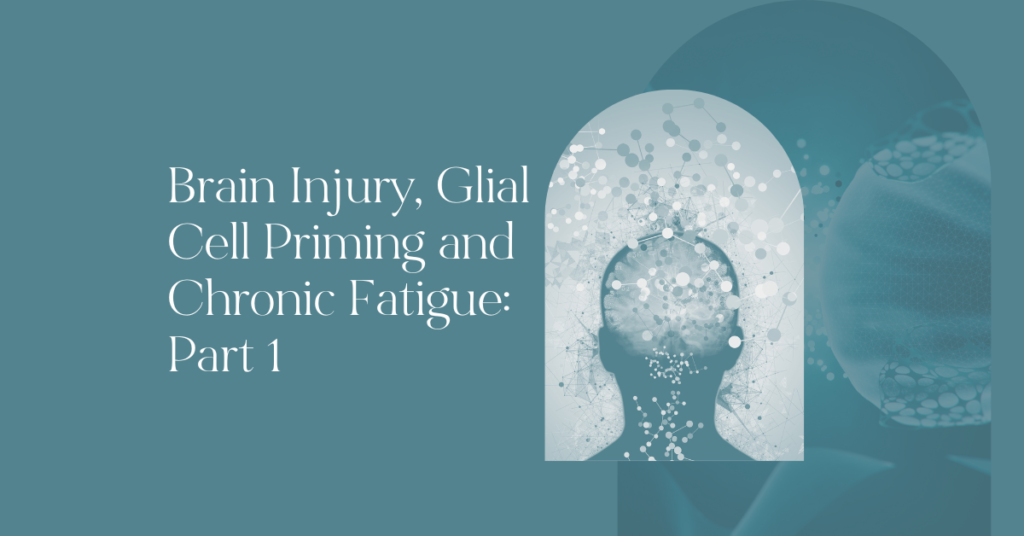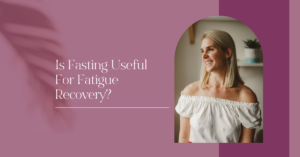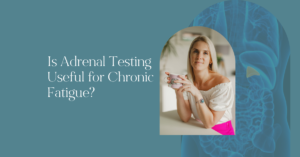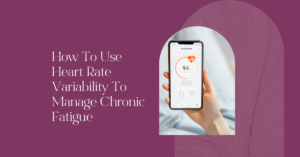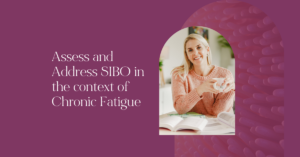Brain injuries and glial cell priming are something that I am frequently seeing in clinical practice as I support clients with Chronic Fatigue. I have previously written on the topic of neuroinflammation but would like to offer an expanded viewpoint where I discuss the microglia in more detail and how they may be susceptible to priming in cases of brain injury.
Whether or not you have a known brain injury, I suggest that you take the time to read this article if you experience any of the following:
- Low mood
- Brain fog
- Excessive need for sleep
- Fatigue that gets worse when you use your brain
- Fatigue that got worse after an injury, accident or illness
- An overall sense of “slowness”
- Difficulty with your memory or finding words
This is a 3 part series separated as follows:
- Understanding brain injuries, neuroinflammation and glial cell priming
- Diet, lifestyle, nutraceutical interventions that may positively impact the health of your brain
- Understanding the importance of the blood brain barrier (BBB) and how to support it
What is a brain injury?
A brain injury refers to any damage or trauma that occurs to the brain, resulting in temporary or permanent disruption of its normal functioning. Brain injuries can range from mild to severe, and they can have varying effects on an individual’s physical, cognitive, and emotional well-being.
Brain injuries can occur due to several causes, including:
Traumatic Brain Injury (TBI)
This type of brain injury is caused by a sudden external force or impact to the head, such as a fall, motor vehicle accident, sports-related injury, or assault. Concussion may be the result of a head trauma but you do not have to experience a concussion to sustain a TBI.
Acquired Brain Injury (ABI)
ABI refers to brain injuries that occur after birth and are not hereditary or congenital. Examples include brain injuries resulting from strokes, infections (e.g., meningitis or encephalitis), oxygen deprivation (e.g., near-drowning or cardiac arrest), tumours or toxic exposure. Mould mycotoxins can cross the Blood Brain Barrier (BBB) and impact the brain, whether we would class this as an “Injury” I am not 100% certain but when I consider my own brain health and how it has been impacted, I feel this is possible.
Neuroinflammation and Brain Injuries
Neuroinflammation refers to inflammation in the brain and spinal cord. Acute neuroinflammation is a natural immune response. In the event of an infection or injury, a small amount of neuroinflammation can be self protective.
However, chronic neuroinflammation is problematic and underpins disease pathophysiology. It can lead to progressive damage and dysfunction of neurons and other brain cells, contributing to the development and progression of dis-ease over time.
Chronic neuroinflammation may be the consequence of a brain injury. It slows down the conduction of nerve impulses and this shows clinically as fatigue, poor mental endurance, brain fog, losing words, difficulty finding thoughts and words.
It may show clinically as follows:
Mild Neuroinflammation
- Brain Fog; hazy thoughts, struggle to recall
- Noticeable variation in mental speed (comes and goes)
- Reduced brain endurance: you can still do things but cannot do things for as long as you used to.
- Loss of endurance but not loss of function e.g. your brain still functions but you lack stamina
- Brain fatigue after exposure to specific chemicals, scents, pollutants
- Brain fatigue after exposure to a specific food e.g. gluten
Moderate Neuroinflammation – “Sickness Behaviour Syndrome”
- Chronic depression
- Inability to concentrate for long periods of time
- Sleepiness – need large amounts of sleep to function
- Chronic Fatigue
- Low motivation
- Loss of appetite
- Cannot be physically active
Severe
- Dementia, personality or behaviour changes
- Confusion, disorientation
- Difficulty Speaking
- Trembling, tremors, involuntary twitching
- Seizures
- Coma
These are all examples of neuroinflammation, however, we can have Neuroinflammation on its own or Neuroinflammation with glial cell priming, which is more likely when there has been a brain injury.
I have written more extensively on neuroinflammation in the blog post, “Neuroinflammation: The Big Rocks for Brain Health” therefore, in this post, I would like to go another layer deeper and explain the important concept of glial cell priming, which is relevant to brain injuries.
Understanding Glial Cell Priming
Neuroinflammation involves the activation of the immune system in the brain, including immune cells such as microglia and astrocytes, as well as the release of various inflammatory molecules such as cytokines, chemokines, and reactive oxygen species (ROS).
Only 10% of brain cells are neurons and the remaining 90% of the human brain is made up of glial cells. The brains immune system is different to the immune system of the rest of the body (systemic immune system). The systemic immune system is turning over immune cells, because the body can make more immune cells in the bone marrow. But the brain is different, it has a fixed number of immune cells and therefore, we have to look after the brain immune system very carefully.
When glial cells become primed it means that they permanently transition from a resting M0 state to either a proinflammatory state, known as M1, or antiinflammatory state known as M2. In other words, the brain immune system has been permanently “switched on” or “activated”.
Once glial cells are primed, their structure is forever changed. They cannot change back to an M0 state, they can only change between M1 and M2. Essentially the brain’s immune system becomes permanently activated and it cannot be turned off, we can only change if the nature of the activation i.e. proinflammatory or antiinflammatory.
This is important because it means that once a glial cell becomes primed, it needs to be managed lifelong. If you are someone who is experiencing fatigue and you have primed glial cells, you may need to be extra judicious with your self care, long term.
In cases of chronic cognitive decline and dysfunction, proinflammatory M1 glial cells are hyperactive and dampening antiinflammatory M2 glial cells are suppressed. This shifts the inflammatory state of the brain or specific regioms of the brain. The priority for clinical intervention is to activate the antiinflammatory M2 glial cells and inhibit proinflammatory M1 glial cells. I will discuss more about how this is done in part 2 of this series.
Brain injury can be a common cause of the phenomenon known as “Glial Cell Priming”. Not all brain injuries may prime the microglia but symptoms can be delayed for up to 20 years after an injury. This means that incidents happen and get forgotten about and then an individual may not feel well and they don’t know why.
A bump on the head may not cause any issues, which makes it easy to forget about it as a significant contributing factor to your health. However, it can become problematic as we naturally experience more glial cell priming with age or, if a secondary infection (e.g. a virus, parasite or bacterial infection) becomes a trigger, increasing the inflammatory cascade. For this reason, brain injuries / glial cell priming is often missed in cases of chronic fatigue.
In addition to brain injury, glial cell priming can also be caused by:
- Stroke
- Haemorrhage
- Chronic stress, trauma and PTSD
- Infections if they can get into the brain (Virus, bacterial, mould, spirochetes etc)
- Ageing due to the build up of oxidative stress and inflammation
How do you know if a brain injury / glial cell priming is relevant to your chronic fatigue?
Unfortunately there are no reliable tests for brain injury and glial cell priming outside of research settings. MRIs may appear “normal” apart from white matter hyperintensities which are normalised as signs of ageing.
In a clinical setting we must consider:
Symptoms
- Chronic depression
- Inability to concentrate for long periods of time
- Sleepiness – need large amounts of sleep to function
- Fatigue; feeling tired and unable to work a full day
- Low motivation
- Loss of appetite
- Cannot be physically active
- Bed wetting in children
- Struggling with sensory input e.g. movement, light, sound etc.
Severity of Symptoms
Are symptoms chronic or intermittent. Do they cause a complete loss of function for hours or days or a mild or moderate disturbance to function for a short period of time? When there is severe dysfunction causes by small exposures of stimuli, we may want to consider glial cell priming.
What Makes Symptoms Better or Worse?
Someone can have neuroinflammation without extensive glial cell priming. We will all have a certain degree of glial cell priming but when it becomes excessive it may present as:
- Small triggers causing a loss of function e.g. loss of function when eating certain foods / chemical exposures, very sensitive to alcohol, struggles to function without adequate sleep, loses cognitive function when they have the flu.
- There is a chronic loss of function which matches the pattern of “sickness behaviour” (see moderate neuroinflammation symptoms above)
Case History
Is there a known accident, head injury or concussion? Did the individual play contact sports? Has the individual had a stroke or brain haemorrhage? Do they have a high ACE (Adverse Childhood Experiences) score? Does the individual have a history of autoimmunity in their family or a diagnosed autoimmune condition which may make them susceptible to neurological autoimmunity? Does the mother or siblings of the individual have autism or developmental disorders? Did the mother have an infection during pregnancy?
Risk Factors
By now you know that a brain injury can prime glial cells and this changes their state and their overall function in the brain. However, not all brain injuries may cause glial cell priming and that is because there are contributing factors involved.
Risk factors that may make someone more likely to develop primed glia include:
- Being diabetic / High Insulin
- Being a smoker or exposed to cigarette smoke
- Having an existing Inflammatory bowel condition
- Consuming a pro-inflammatory diet
- Being hypoxic or anaemic
- A previous brain trauma
- Poor antioxidant reserves
- Vascular inflammation
As an example, a child growing up in a household with parents that smoke, eats a diet high in processed foods, has undiagnosed anaemia plays rugby at school and hits their head. They may be asymptomatic for years but perhaps notice that mood, energy and motivation is a little low at times but it comes and goes. They need a lot of sleep, more so than their peers. They get a bad bout of flu in their 30’s and all of a sudden they are chronically fatigued, depressed and need 12 hours of sleep each night just to get through the day.
This is an example of microglia priming where a secondary infection tips the scales and accelerates the neuroinflammation.
Personal Reflections
When I think back across my lifetime, I have hit my head many times. I’ve never been in a car accident, played contact sports or had a concussion. But other things have happened; such as falling backwards off a fence onto a concrete slab, hitting my head while doing somersaults in the swimming pool, standing up under a metal staircase and whacking my head, falling on a slippery rock and cutting my chin open. I’ve had many “insignificant whacks” across my lifetime and one has to wonder what the possible impact might be? I’ll never know for sure.
Something I still feel unclear on is how mould mycotoxins impact glial cell priming. We know that mycotoxins can cross the blood brain barrier and impact the microglia causing neuroinflammation and they would exacerbate already primed microglia. Whether or not they can prime the microglia, I am unsure of for now. You can read more about how myoctoxins impact the brain here.
I know when I expose myself to triggers, I am most affected in my brain, specifically with brain fog. It was the first symptom that I have and still one that I experience now and again today. It is definitely more of a problem at times in my cycle when oestrogen is lower, when I lose the antiinflammatory benefits of the hormone.
The brain is highly susceptible to oxidative stress and has a poor antioxidant system generally. The microglia are responsible for making antioxidants but they can become depleted when the brain is inflamed.
The biggest trigger for the brain fog that I experience is exercise, I suspect due to the oxidative stress. At the lowest point of my fatigue experience even walking would be a challenge at times. I was very nutritionally depleted due to chronic diarrhoea. This, combined with mould mycotoxins, meant by endogenous antioxidant reserves very very low.
Part of my journey has been repleting antioxidants and building exercise tolerance. I am now it a very different place where I am gyming, swimming and walking at least 8 thousands steps a day. But, when I do something a little extra challenging, I feel it in my brain.
What makes sense to me at this point in time, with the knowledge that I have so far, is that I have a certain degree of glial cell priming (we all have some after all and this gets worse as we age) and I am experiencing a “secondary hit” from time to time when I push my body too hard.
In a way this theory and understanding has been somewhat reassuring. It has moved me from being constantly suspicious that I still have an issue with mould or that I didn’t “try hard enough” at my mindbody work, to rather understanding and better managing, the triggers that are created as part of my daily routines.
When you read part 2 of this series, you will also learn about the supplements that are beneficial to support M2 glial cell, interestingly, many of these are the ones I still take currently and have found noticeably beneficial in my journey.
Conclusion
I hope you have enjoyed learning a bit more about your brain and its glial cells. Perhaps it has helped you, like me, to reflect on why you may feel the way you feel, and why certain things are triggering for you and why perhaps you do need to stick to some very specific self care routines from which you struggle to deviate.
In part 2 of this series we will discuss what you can do to support your brain health and the antiinflammatory state of your glial cells.

